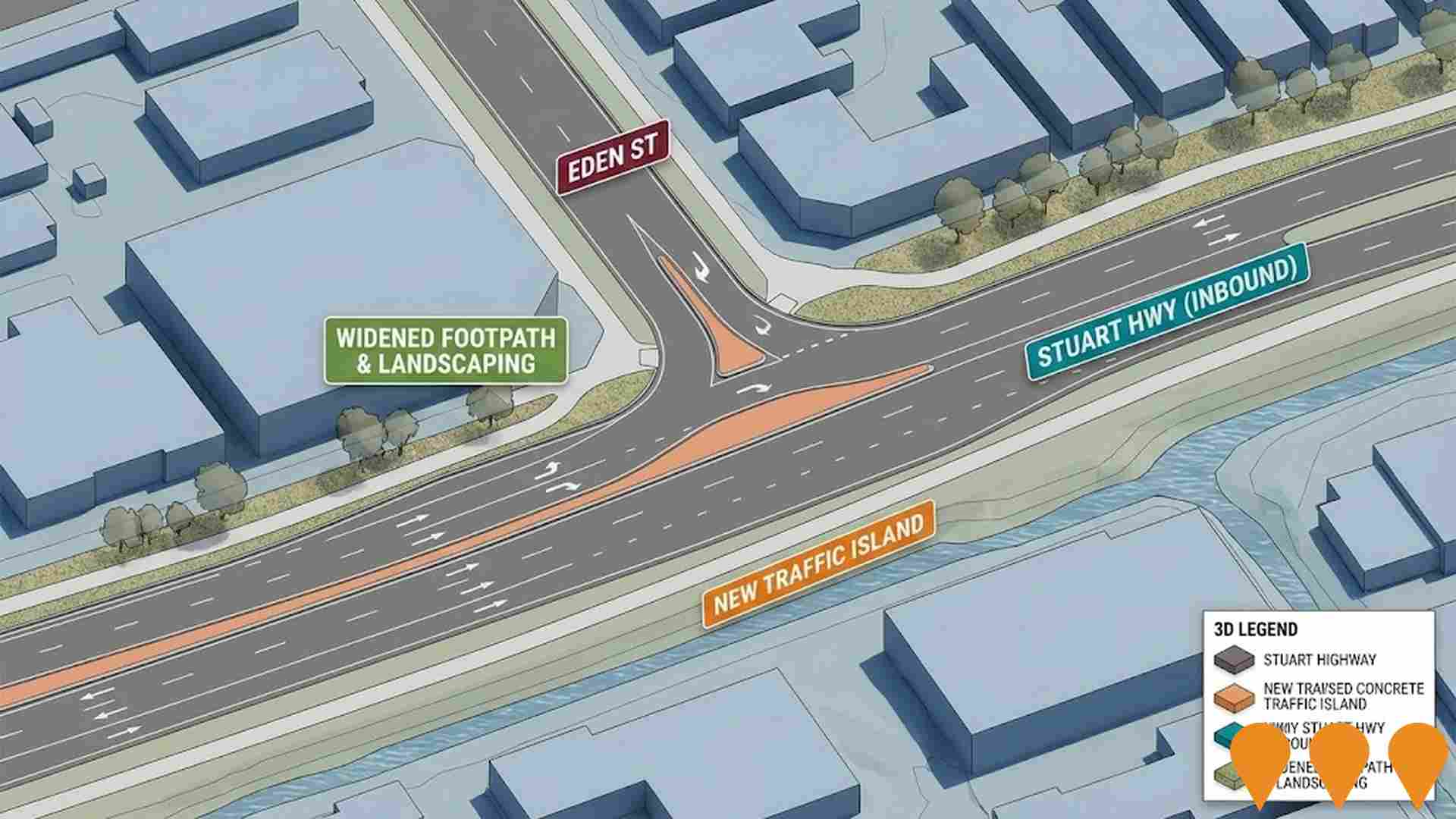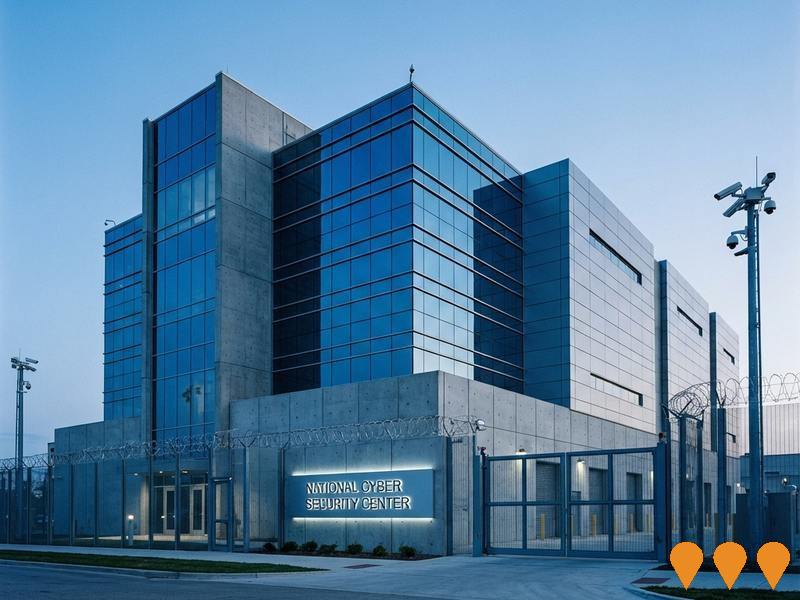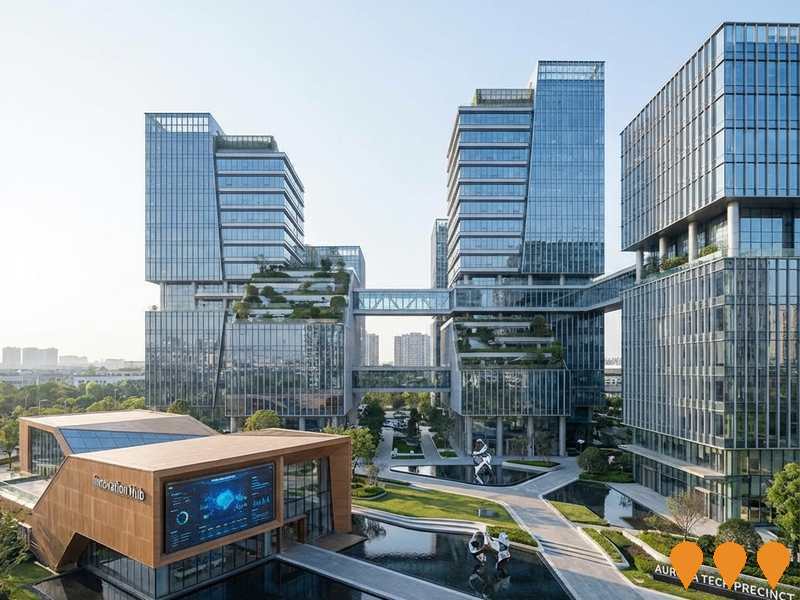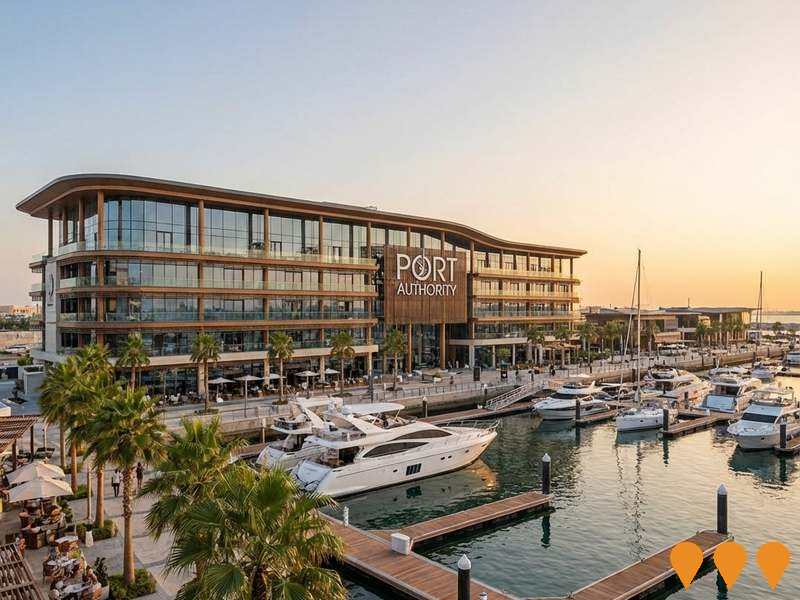Chart Color Schemes
est. as @ -- *
ABS ERP | -- people | --
2021 Census | -- people
Sales Activity
Curious about local property values? Filter the chart to assess the volume and appreciation (including resales) trends and regional comparisons, or scroll to the map below view this information at an individual property level.
Find a Recent Sale
Sales Detail
Population
An assessment of population growth drivers in Woolner - Bayview - Winnellie reveals an overall ranking slightly below national averages considering recent, and medium term trends
Woolner - Bayview - Winnellie's population is around 2,890 as of Aug 2025. This reflects an increase of 32 people since the 2021 Census, which reported a population of 2,858 people. The change is inferred from the estimated resident population of 2,843 from the ABS as of June 2024 and an additional 14 validated new addresses since the Census date. This level of population equates to a density ratio of 425 persons per square kilometer. Population growth was primarily driven by overseas migration contributing approximately 52.4% of overall population gains during recent periods.
AreaSearch is adopting ABS/Geoscience Australia projections for each SA2 area, released in 2024 with a base year of 2022. For areas not covered by this data and to estimate growth post-2032, AreaSearch applies growth rates by age cohort provided by the ABS in its latest Greater Capital Region projections (released in 2023, based on 2022 data). Population projections indicate an increase just below the median of statistical areas across the nation by Aug 2041, with Woolner - Bayview - Winnellie expected to grow by 295 persons, reflecting an increase of 8.3% over the 17-year period.
Frequently Asked Questions - Population
Development
The level of residential development activity in Woolner - Bayview - Winnellie is very low in comparison to the average area assessed nationally by AreaSearch
Woolner-Bayview-Winnellie has averaged approximately one dwelling receiving development approval annually. Between financial years 2021 (FY-21) and 2025 (FY-25), seven homes were approved, with no approvals recorded so far in FY-26. Despite population decline, the area's development activity has been relatively adequate.
New properties are constructed at an average expected construction cost of $1,256,000, indicating a focus on the premium segment. This year, $18.5 million in commercial development approvals have been recorded, suggesting balanced commercial development activity. Compared to Greater Darwin, Woolner-Bayview-Winnellie records about 59% of the building activity per person and ranks among the 9th percentile of areas assessed nationally, offering more limited choices for buyers and supporting demand for existing dwellings. Recent building activity consists entirely of standalone homes, preserving the area's low density nature and attracting space-seeking buyers.
Developers are building more traditional houses than the current mix suggests, indicating strong demand for family homes despite density pressures. Future projections estimate Woolner-Bayview-Winnellie will add 241 residents by 2041. If current development rates continue, housing supply may not keep pace with population growth, potentially increasing competition among buyers and supporting stronger price growth.
Frequently Asked Questions - Development
Infrastructure
Woolner - Bayview - Winnellie has limited levels of nearby infrastructure activity, ranking in the 13thth percentile nationally
The performance of a region can significantly influenced by changes in local infrastructure, major projects, and planning initiatives. AreaSearch has identified 11 such projects that are expected to impact the area. Notable ones include Darwin Desalination Plant, Royal Darwin Hospital Expansion, Darwin Residential Development - Berrimah, and Stuart Highway Road Safety Improvements - Stuart Park. The following list details those considered most relevant.
Professional plan users can use the search below to filter and access additional projects.
INFRASTRUCTURE SEARCH
 Denotes AI-based impression for illustrative purposes only, not to be taken as definitive under any circumstances. Please follow links and conduct other investigations from the project's source for actual imagery. Developers and project owners wishing us to use original imagery please Contact Us and we will do so.
Denotes AI-based impression for illustrative purposes only, not to be taken as definitive under any circumstances. Please follow links and conduct other investigations from the project's source for actual imagery. Developers and project owners wishing us to use original imagery please Contact Us and we will do so.
Frequently Asked Questions - Infrastructure
Royal Darwin Hospital Expansion
$125 million hospital expansion adding 150 beds, new emergency department, and specialized cardiac and cancer treatment facilities to serve the growing Top End population.

Darwin Desalination Plant
$180 million seawater desalination plant producing 35 million litres per day to secure Darwin's water supply and support population growth.

Richardson Park Community Space
NT Government revitalised Richardson Park into a community sports and recreation precinct with two multi-purpose playing fields, shared path with lighting, picnic shelters and barbecue areas, new access road to Ludmilla Primary School and amenities including change rooms, toilets, storage, outdoor gym and playground. The project preserves the site's rugby league heritage and is now open for community use.

Marine Industry Park
Marine and offshore industries servicing hub at East Arm, Darwin. Stage 1 planning approval is secured for a purpose-built industrial subdivision near the new Darwin Ship Lift, with expressions of interest open for serviced lots. Existing common-user facilities include an all-tide barge ramp (first point of entry) and a secure hardstand supporting storage and fabrication activities.

Hudson Creek Power Station
12MW natural gas-fired power plant, NT's first privately owned grid-connected gas generation facility. Features 25% lower emissions than average NT gas generators. Part of dual project with Batchelor Solar Farm, creating 162 construction jobs and providing vital grid stability to Darwin-Katherine network.

Stuart Highway Road Safety Improvements - Stuart Park
Road safety upgrades along Stuart Highway in Stuart Park to separate turning traffic from through traffic and provide full protection for pedestrians and cyclists at signals. Concept designs indicate dedicated left turn lanes at Armidale Street, Eden Street, Charles Street and Westralia Street, with improved line marking and signage. Project is in early design planning; construction subject to funding following detailed design.

Defence Establishment Berrimah Redevelopment
Significant infrastructure upgrades focusing on essential in-ground services including power supply, water and fire water systems, sewerage systems, ICT infrastructure, and security upgrades. Additional improvements to internal roads if budget permits.

Darwin Corporate Park
Darwin Corporate Park is a premier business park for mixed use commercial office space located in what is now recognised as the centre of greater Darwin.

Employment
Employment conditions in Woolner - Bayview - Winnellie rank among the top 10% of areas assessed nationally
Woolner-Bayview-Winnellie has a highly educated workforce with significant representation in essential services sectors. Its unemployment rate was 0.9% as of June 2021, with an estimated employment growth of 3.0% over the past year.
As of June 2025, there are 2,073 residents employed, with an unemployment rate of 2.1%, lower than Greater Darwin's 3.0%. Workforce participation is high at 80.2%, compared to Greater Darwin's 69.7%. The dominant employment sectors include public administration & safety, health care & social assistance, and accommodation & food. Professional & technical services have notable concentration, with employment levels at 1.4 times the regional average.
However, public administration & safety shows lower representation at 18.4% versus the regional average of 19.5%. There are 2.3 workers for every resident, indicating it functions as an employment hub attracting workers from surrounding areas. In the year to June 2025, employment levels increased by 3.0%, and labour force grew by 2.9%, with unemployment remaining essentially unchanged. National employment forecasts suggest growth of approximately 6.5% over five years and 13.4% over ten years for Woolner-Bayview-Winnellie, based on industry-specific projections applied to its local employment mix.
Frequently Asked Questions - Employment
Income
The economic profile demonstrates exceptional strength, placing the area among the top 10% nationally based on comprehensive AreaSearch income analysis
Woolner - Bayview - Winnellie had a median taxpayer income of $80,260 and an average income of $99,080 in the financial year 2022, according to postcode level ATO data aggregated by AreaSearch. This places it among the top percentile nationally, contrasting with Greater Darwin's median income of $65,522 and average income of $75,260. Based on a Wage Price Index growth rate of 12.01% since financial year 2022, estimated incomes as of September 2025 would be approximately $89,899 (median) and $110,980 (average). Census 2021 income data shows household, family, and personal incomes in Woolner - Bayview - Winnellie ranked highly nationally, between the 96th and 97th percentiles. The earnings profile shows that 34.7% of residents (1,002 people) fell into the $1,500 - $2,999 weekly income bracket, aligning with regional levels where this cohort represented 36.7%. Woolner - Bayview - Winnellie demonstrated affluence with 46.4% of residents earning over $3,000 per week, supporting premium retail and service offerings. Housing accounted for 14.4% of income. Strong earnings placed residents within the 95th percentile for disposable income, and the area's SEIFA income ranking placed it in the 9th decile.
Frequently Asked Questions - Income
Housing
Woolner - Bayview - Winnellie features a more urban dwelling mix with significant apartment living, with above-average rates of outright home ownership
In Woolner - Bayview - Winnellie, as per the latest Census evaluation, 34.3% of dwellings were houses while 65.7% consisted of other types such as semi-detached homes, apartments, and 'other' dwellings. This contrasts with Darwin metro's figures of 23.6% houses and 76.4% other dwellings. Regarding home ownership in Woolner - Bayview - Winnellie, it stood at 18.4%, with mortgaged dwellings at 28.1% and rented ones at 53.5%. The median monthly mortgage repayment in the area was $2,248, surpassing Darwin metro's average of $2,000. Meanwhile, the median weekly rent figure for Woolner - Bayview - Winnellie was recorded at $490, compared to Darwin metro's $420. Nationally, Woolner - Bayview - Winnellie's mortgage repayments were significantly higher than the Australian average of $1,863, while rents were substantially above the national figure of $375.
Frequently Asked Questions - Housing
Household Composition
Woolner - Bayview - Winnellie features high concentrations of group households, with a higher-than-average median household size
Family households comprise 68.5% of all households, including 29.7% couples with children, 29.5% couples without children, and 8.8% single parent families. Non-family households account for the remaining 31.5%, with lone person households at 22.5% and group households comprising 8.5%. The median household size is 2.5 people, which is larger than the Greater Darwin average of 2.3.
Frequently Asked Questions - Households
Local Schools & Education
Woolner - Bayview - Winnellie shows strong educational performance, ranking in the upper quartile nationally when assessed across multiple qualification and achievement indicators
Woolner-Bayview-Winnellie has a higher level of educational attainment than broader benchmarks. 41.9% of residents aged 15 years and above have university qualifications, compared to 27.3% in the Northern Territory and 30.4% nationally. Bachelor degrees are the most common at 27.7%, followed by postgraduate qualifications (10.2%) and graduate diplomas (4.0%). Vocational credentials are also prevalent, with 33.0% of residents aged 15 years and above holding them – advanced diplomas (11.3%) and certificates (21.7%).
Educational participation is high, with 31.6% of residents currently enrolled in formal education. This includes 9.4% in primary education, 7.9% in secondary education, and 7.9% pursuing tertiary education. Educational facilities appear to be located outside the immediate catchment boundaries, requiring families to access schools in neighboring areas.
Frequently Asked Questions - Education
Schools Detail
Nearby Services & Amenities
Transport
Transport servicing is high compared to other areas nationally based on assessment of service frequency, route connectivity and accessibility
Woolner-Bayview-Winnellie has 35 operational public transport stops. These are served by a total of 68 bus routes, which facilitate 5,583 weekly passenger trips in the area. The average distance to the nearest stop for residents is 251 meters.
Daily service frequency averages 797 trips across all routes, equating to around 159 weekly trips per individual stop.
Frequently Asked Questions - Transport
Transport Stops Detail
Health
Woolner - Bayview - Winnellie's residents boast exceedingly positive health performance metrics with very low prevalence of common health conditions across all age groups
Health outcomes data shows exceptional results across Woolner - Bayview - Winnellie, with very low prevalence of common health conditions across all age groups. The rate of private health cover is approximately 71% of the total population (2,051 people), compared to 61.3% across Greater Darwin and a national average of 55.3%. The most prevalent medical conditions are asthma at 5.2%, and mental health issues at 5.0%.
A total of 81.1% of residents declare themselves completely clear of medical ailments, compared to 79.9% across Greater Darwin. The area has 7.7% (223 people) of residents aged 65 and over, lower than the 11.0% in Greater Darwin. Health outcomes among seniors are particularly strong, broadly aligning with the general population's health profile.
Frequently Asked Questions - Health
Cultural Diversity
Woolner - Bayview - Winnellie was found to be more culturally diverse than the vast majority of local markets in Australia, upon assessment of a range of language and cultural background related metrics
Woolner-Bayview-Winnellie was found to be more culturally diverse than most local markets, with 33.2% of its population born overseas and 28.6% speaking a language other than English at home. Christianity is the main religion in Woolner-Bayview-Winnellie, comprising 45.5% of people. Buddhism is overrepresented compared to Greater Darwin, making up 3.8% of Woolner-Bayview-Winnellie's population versus 4.1%.
The top three ancestry groups are English (21.7%), Australian (19.2%), and Other (12.6%). Greek (4.6%) is notably overrepresented compared to the regional average of 2.0%, while Sri Lankan (0.6% vs 0.7%) and Filipino (2.2% vs 2.9%) show notable divergences in representation.
Frequently Asked Questions - Diversity
Age
Woolner - Bayview - Winnellie's population is younger than the national pattern
Woolner - Bayview - Winnellie's median age is 34 years, matching Greater Darwin's average of 34 but lower than Australia's median of 38. Compared to Greater Darwin, Woolner - Bayview - Winnellie has a higher proportion of residents aged 25-34 (22.4%) but fewer residents aged 5-14 (10.1%). This 25-34 concentration is significantly higher than the national average of 14.5%. Between 2021 and present, the population aged 35 to 44 has increased from 16.1% to 17.8%, while the 45 to 54 cohort has declined from 16.0% to 13.8%, and the 5 to 14 age group has dropped from 11.6% to 10.1%. By 2041, demographic modeling suggests significant changes in Woolner - Bayview - Winnellie's age profile. The 45 to 54 cohort is projected to grow steadily, increasing by 86 people (22%) from 397 to 484. Conversely, the 5 to 14 and 0 to 4 age groups are expected to experience population declines.



